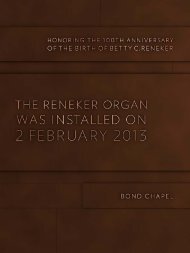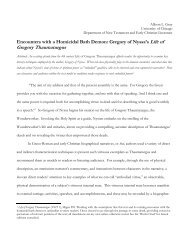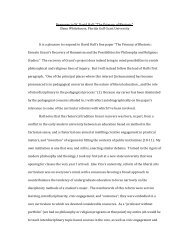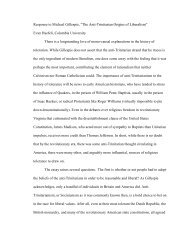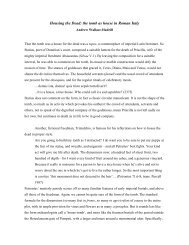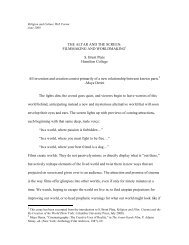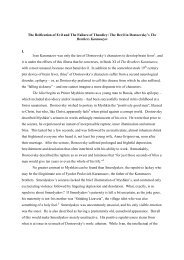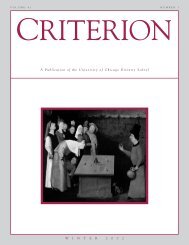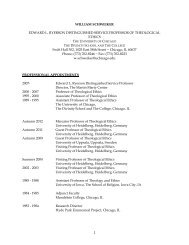Nota Bene - University of Chicago
Nota Bene - University of Chicago
Nota Bene - University of Chicago
Create successful ePaper yourself
Turn your PDF publications into a flip-book with our unique Google optimized e-Paper software.
cippus dedicated to “our sweet Secundus” by his parents (Fig. XX), or another ornament, like a<br />
wreath, such as the elaborate Roman funerary monument <strong>of</strong> Q. Sulpicius Maximus, from the<br />
first century (which, like Abercius, has a poem in Greek inscribed) (Fig. XX). Was it as ornate<br />
on top and elevated above street level as that <strong>of</strong> C. Etuvius Capreolous in Aquilei? (Fig. XX)<br />
What else would have marked Abercius’ monument as a βωμο� ς, and what associations would it<br />
evoke? We shall return to these questions below.<br />
2. How many inscriptions are there in “the Abercius inscription,” and where were they<br />
placed on the stone(s)?<br />
One <strong>of</strong> the most important interpretive issues is whether Abercius’ monument was<br />
originally composed <strong>of</strong> one or more inscriptions, 55 and how the inscription(s) were arranged on<br />
the original cippus and/or base. Earlier scholarship emphasized a variety <strong>of</strong> theories for the<br />
disposition <strong>of</strong> the words known from the literary traditions, as confirmed by the various parts<br />
preserved on the two inscriptions. 56 A champion <strong>of</strong> the unity <strong>of</strong> the 22 line inscription and its<br />
placement on a single face, Antonio Ferrua, nonetheless acknowledged in 1943 that “E per<br />
farla breve, e� opinione corrente che su tre facce fosse distribuita l’iscrizione.” 57 In that same<br />
publication he argued, as the Vatican Museum reconstruction brings to plastic life, that vv. 1-6<br />
were arranged on the top <strong>of</strong> the stone in the lintel, the poetic section <strong>of</strong> vv. 7-18 neatly set<br />
within the framed text-panel, and the final prose section on the base. That viewpoint was<br />
reiterated in a 1999 publication. 58 Ferrua and the Vatican Museum curators thereafter have<br />
------------------------------------<br />
Page 16<br />
55<br />
We should also acknowledge the possibility that we do not have a record <strong>of</strong> the full inscriptional material<br />
that was on the “original” Abercius monument. This is empirically possible, i.e., that the hagiographer either missed<br />
or on purpose did not record as part <strong>of</strong> the inscription some <strong>of</strong> what he had seen. This is most likely in the case <strong>of</strong> a<br />
date marker, for instance, as the day <strong>of</strong> the saint’s death is recorded in the vita Abercii 80 [55] as 22 October, but not<br />
presented as part <strong>of</strong> the inscription. We should also note the possibility that by the time <strong>of</strong> the literary author not all<br />
<strong>of</strong> the original inscription was still legible. This is in fact stated in the version by Simeon Metaphrastes, which states<br />
after the inscription is given: τα� με�ν δη� του� ε� πιγρα� μματος ω� δε� πως ε� πι� λε�ξεως ει�χεν, ο� τι μη� ο� χρο� νος υ� φει�λε κατ’<br />
ο� λι�γον τη�ς α� κριβει�ας και� η� μαρτημε�νως ε�χειν τη� ν γραφη� ν παρεσκευ� σεν (“now the words <strong>of</strong> the inscription are given<br />
here pretty much word for word, except that time has taken away a bit from the accuracy <strong>of</strong> reading, and has<br />
rendered the inscription in a faulty manner ” [77 (122)]).<br />
56<br />
See the summary <strong>of</strong> late 19th and early 20th century scholarship in Ferrua, “Nuove osservazione<br />
sull’epitaphio die Abercio,” 281-186.<br />
57<br />
“Nuove osservazioni sull’ epitaffio de Abercio,” 286.<br />
58<br />
“A. epitaphium in una facie inscriptum esse arbitramur contra omnes qui in tribus seu quattuor faciebus<br />
inscriptum esse putaveruntis” (A. Ferrua and D. Balboni, “Epitaphium Abercii,” Latinitas 47 [1999] 153-57, 156; see



